Approximation Framework of Embodied Energy of Safety: Insights and Analysis
Abstract
1. Introduction
- Provides a holistic view of the long-term energy and fuel consequences of motor vehicle crashes, taking into account not only induced congestion and induced vehicle miles traveled (VMT), but also the consequence of the energy impact of induced activities (emergency response, health care, rehabilitation, vehicle repair), longer-term consequence of loss of human productivity, and society’s willingness to pay to avoid those consequences.
- Develops an EES approximation model with temporal (multiple years) and spatial (various regional scales) dimensions considering the data availability.
- Strengthens the connection between safety and energy for quantifying the overall performance of transportation systems. The latter is needed to understand that the ability of emerging technology to make transportation safer (without any improvement in traffic flow dynamics) also has a measurable energy impact.
2. Background and Data Preparation
2.1. Energy and Motor Vehicle Crashes
2.2. Crash and Cost Composition
- (K): Fatal Injury
- (A): Suspected serious injury
- (B): Suspected minor injury
- (C): Possible injury
- (O): No apparent injury
- (MAIS6): Unsurvivable injury
- (MAIS5): Critical injury
- (MAIS4): Severe injury
- (MAIS3): Serious injury
- (MAIS2): Moderate injury
- (MAIS1): Minor injury
- (MAIS0): No injury
- SWC = severity-weighted cost for two or more severities;
- C = crash unit cost or person-injury unit cost for a given severity;
- N = number of crashes or person-injuries of given severity or group of severities.
2.3. Energy Equivalence of Crash Cost
2.4. GDP-Weighted Energy Perspective
3. Energy Equivalence of Safety Framework
4. Energy Estimation Results Analysis
4.1. Crash Number and Economic Cost
4.2. Gasoline Gallon Equivalent of Crash Cost
4.3. EES Analysis in Various Regional Scales
5. Conclusions
Author Contributions
Funding
Acknowledgments
Conflicts of Interest
Abbreviations
| AASHTO | American Association of State Highway Transportation Officials |
| AIS | Abbreviated Injury Scale |
| Btu | British thermal unit |
| CDS | Crashworthiness Database System |
| CISS | Crash Investigation Sampling System |
| CPI | Consumer Price Index |
| CRSS | Crash Report Sampling System |
| EER | energy equivalence rate |
| EES | energy equivalence of safety |
| EIA | Energy Information Administration |
| EPA | U.S. Environmental Protection Agency |
| EPDO | equivalent property damage only |
| GDP | gross domestic product |
| GES | General Estimate System |
| GGE | gasoline gallon equivalent |
| HSM | Highway Safety Manual |
| MAIS | Maximum Abbreviated Injury Scale |
| MOVES | Multi-scale mOtor Vehicle and equipment Emission System |
| MUWE | median usual weekly earnings |
| NHTSA | National Highway Transportation Safety Administration |
| PDO | property damage only |
| QALY | quality-adjusted life years |
| quad | quadrillion (1015) Btu |
| VMR | value of mortality risk |
| VMT | vehicle miles traveled |
| VSL | value of a statistical life |
References
- Papadoulis, A.; Quddus, M.; Imprialou, M.-I.M. Evaluating the safety impact of connected and autonomous vehicles on motorways. Accid. Anal. Prev. 2019, 124, 12–22. [Google Scholar] [CrossRef] [PubMed]
- Virdi, N.; Grzybowska, H.; Waller, S.T.; Dixit, V.V. A safety assessment of mixed fleets with Connected and Autonomous Vehicles using the Surrogate Safety Assessment Module. Accid. Anal. Prev. 2019, 131, 95–111. [Google Scholar] [CrossRef] [PubMed]
- Martin-Gasulla, M.; Sukennik, P.; Lohmiller, J. Investigation of the Impact on Throughput of Connected Autonomous Vehicles with Headway Based on the Leading Vehicle Type. Transp. Res. Rec. J. Transp. Res. Board 2019, 2673, 617–626. [Google Scholar] [CrossRef]
- Gettman, D.; Head, K.L. Surrogate Safety Measures from Traffic Simulation Models. Transp. Res. Rec. J. Transp. Res. Board 2003, 1840, 104–115. [Google Scholar] [CrossRef]
- National Highway Traffic Safety Administration. Traffic Safety Facts Annual Report 2019. Available online: https://cdan.nhtsa.gov/tsftables/tsfar.htm (accessed on 4 May 2020).
- De Leur, P.; Eng, P.; Thue, L.; Ladd, M.B. Capital Region Intersection Safety Partnership. Available online: https://drivetolive.ca/blog/2018/06/15/updated-cost-of-collision-study/ (accessed on 10 July 2010).
- Zhu, L.; Young, S.E.; Day, C.M. Exploring First-Order Approximation of Energy Equivalence of Safety at Intersections; National Renewable Energy Lab.(NREL): Golden, CO, USA, 2019. [Google Scholar]
- Ogden, K.W. Safer Roads: A Guide to Road Safety Engineering; Ashgate: Aldershot, UK, 1996. [Google Scholar]
- Mannering, F.L.; Shankar, V.N.; Bhat, C.R. Unobserved heterogeneity and the statistical analysis of highway accident data. Anal. Methods Accid. Res. 2016, 11, 1–16. [Google Scholar] [CrossRef]
- Sobhani, A.; Young, W.; Logan, D.; Bahrololoom, S. A kinetic energy model of two-vehicle crash injury severity. Accid. Anal. Prev. 2011, 43, 741–754. [Google Scholar] [CrossRef]
- Schmidová, N.; Zavřelová, T.; Vašíček, M.; Zavadil, F.; Růžička, M.; Rund, M. Development of Adaptable CFRP Energy Absorbers for Car Crashes. Mater. Today Proc. 2018, 5, 26784–26791. [Google Scholar] [CrossRef]
- Zhang, X.; Jin, X.; Li, Y.; Li, G. Improved design of the main energy-absorbing automotive parts based on traffic accident analysis. Mater. Des. 2008, 29, 403–410. [Google Scholar] [CrossRef]
- Reddy, T.; Narayanamurthy, V.; Rao, Y. Evolution of a new geometric profile for an ideal tube inversion for crash energy absorption. Int. J. Mech. Sci. 2019, 155, 125–142. [Google Scholar] [CrossRef]
- Sivasaravanan, S.; Raja, V.B.; Kumar, P.S.; Vardhan, V.H. Fabrication of Porous Composite Material for Crash Energy Absorption. Mater. Today Proc. 2019, 16, 972–977. [Google Scholar] [CrossRef]
- Kaczyński, P.; Gronostajski, Z.; Polak, S. Progressive crushing as a new mechanism of energy absorption. The crushing study of magnesium alloy crash-boxes. Int. J. Impact Eng. 2019, 124, 1–8. [Google Scholar] [CrossRef]
- Chung, Y.; Recker, W.W. Spatiotemporal Analysis of Traffic Congestion Caused by Rubbernecking at Freeway Accidents. IEEE Trans. Intell. Transp. Syst. 2013, 14, 1416–1422. [Google Scholar] [CrossRef]
- Eisele, W.L.; Schrank, D.L.; Bittner, J.; Larson, G. Incorporating Urban-Area Truck Freight Value into the Urban Mobility Report. Transp. Res. Rec. J. Transp. Res. Board 2013, 2378, 54–64. [Google Scholar] [CrossRef]
- Koupal, J.; Cumberworth, M.; Michaels, H.; Beardsley, M.; Brzezinski, D. Design and implementation of MOVES: EPA’s new generation mobile source emission model. Ann Arbor 2003, 1001, 105. [Google Scholar]
- Rakha, H.A.; Ahn, K.; Trani, A. Development of VT-Micro model for estimating hot stabilized light duty vehicle and truck emissions. Transp. Res. Part D Transp. Environ. 2004, 9, 49–74. [Google Scholar] [CrossRef]
- Brooker, A.; Gonder, J.; Wang, L.; Wood, E.; Lopp, S.; Ramroth, L. FASTSim: A Model to Estimate Vehicle Efficiency, Cost and Performance. SAE Tech. Pap. Ser. 2015, 1. Available online: https://saemobilus.sae.org/content/2015-01-0973/ (accessed on 8 May 2020).
- Blincoe, L.; Miller, T.R.; Zaloshnja, E.; Lawrence, B.A. The Economic and Societal Impact of Motor Vehicle Crashes, 2010 (Revised); National Highway TrafficSafety Administration: Washington, DC, USA, 2015.
- Radja, G.A. National Automotive Sampling System–Crashworthiness Data System, 2015 Analytical User’s Manual; National Highway TrafficSafety Administration: Washington, DC, USA, 2016.
- National Highway Traffic Safety Administration. NASS General Estimates System. 2019. Available online: https://www.nhtsa.gov/national-automotive-sampling-system-nass/nass-general-estimates-system (accessed on 8 May 2020).
- National Highway Traffic Safety Administration. Crashworthiness Data System. 2019. Available online: https://www.nhtsa.gov/national-automotive-sampling-system-nass/crashworthiness-data-system (accessed on 9 May 2020).
- National Highway Traffic Safety Administration. Crash Report Sampling System (CRSS). 2019. Available online: https://www.nhtsa.gov/crash-data-systems/crash-report-sampling-system-crss (accessed on 8 May 2020).
- National Highway Traffic Safety Administration. Crash Investigation Sampling System (CISS). 2019. Available online: https://www.nhtsa.gov/crash-data-systems/crash-investigation-sampling-system (accessed on 8 May 2020).
- Chen, C.-L.; Subramanian, R.; Zhang, F.; Noh, E.Y. NHTSA’s Data Modernization Project. In Proceedings of the 2015 Federal Committee on Statistical Methodology (FCSM) Research Conference, Washington, DC, USA, 1–3 December 2015. [Google Scholar]
- Harmon, T.; Bahar, G.; Gross, F. Crash Costs for Highway Safety Analysis; Federal Highway Administration: McLean, VA, USA, 2018.
- Najm, W.G.; Smith, J.D.; Yanagisawa, M. Pre-crash Scenario Typology for Crash Avoidance Research. In DOT HS; National Highway TrafficSafety Administration: Washington, DC, USA, 2007. [Google Scholar]
- Silcock, R. Guidelines for estimating the cost of road crashes in developing countries. Lond. Dep. Int. Dev. Proj. 2003, 7780, 2003. [Google Scholar]
- American Association of State Highway and Transportation Officials. Highway Safety Manual; American Association of State Highway Transportation Officials (AASHTO): Washington, DC, USA, 2010.
- Viscusi, W.K.; Aldy, J. The value of a statistical life: A critical review of market estimates throughout the world. J. Risk Uncertain. 2003, 27, 5–76. [Google Scholar] [CrossRef]
- Machina, M.; Viscusi, W.K. Handbook of the Economics of Risk and Uncertainty; Newnes: Oxford, UK, 2013. [Google Scholar]
- Cameron, T.A. Euthanizing the value of a statistical life. Rev. Environ. Econ. Policy 2010, 4, 161–178. [Google Scholar] [CrossRef]
- Robinson, L.A.; Hammitt, J.K. Research Synthesis and the Value per Statistical Life. Risk Anal. 2015, 35, 1086–1100. [Google Scholar] [CrossRef]
- Elias, B. Screening and Securing Air Cargo: Background and Issues for Congress; Congressional Research Service: Washington, DC, USA, 2010.
- Transportation Safety Administration. Air Cargo Screening Final Rule; United States Office of the Federal Register: Washington, DC, USA, 2011.
- Kniesner, T.J.; Viscusi, W.K. The value of a statistical life. Oxford Res. Encycl. Econ. Financ. 2019. Available online: https://papers.ssrn.com/sol3/papers.cfm?abstract_id=3379967#:~:text=The%20value%20of%20a%20statistical%20life%20(VSL)%20is%20the%20local,marginal%20cost%20of%20enhancing%20safety (accessed on 13 August 2020).
- Bosworth, R.; Hunter, A.; Kibria, A.; STRATA. The Value of a Statistical Life: Economics and Politics; STRATA: Logan, UT, USA, 2017. [Google Scholar]
- Bryan, M.; Cecchetti, S. The Consumer Price Index as a Measure of Inflation; National Bureau of Economic Research: Cambridge, MA, USA, 1993.
- Moran, M.J.; Monje, C. Guidance of Treatment of the Economic Value of a Statistical Life in U.S. Department of Transportation Analyses-2016 Adjustment; US Department of Transportation: Washington, DC, USA, 2016.
- Stephan, A.; Stephan, L. Reducing the total life cycle energy demand of recent residential buildings in Lebanon. Energy 2014, 74, 618–637. [Google Scholar] [CrossRef]
- Rauf, A.; Crawford, R.H. The Effect of Material Service Life on the Life Cycle Energy of Residential Buildings. In Proceedings of the ASA2012: The 46th Annual Conference of the Architectural Science Association (formerly ANZAScA)–Building on Knowledge: Theory and Practice, Queensland, Australia, 14–16 November 2012. [Google Scholar]
- Dixit, M.K. Life cycle recurrent embodied energy calculation of buildings: A review. J. Clean. Prod. 2019, 209, 731–754. [Google Scholar] [CrossRef]
- Pagani, M.; De Menna, F.; Johnson, T.G.; Vittuari, M. Impacts and costs of embodied and nutritional energy of food losses in the US food system: Farming and processing (Part A). J. Clean. Prod. 2020, 244, 118730. [Google Scholar] [CrossRef]
- Vittuari, M.; Pagani, M.; Johnson, T.G.; De Menna, F. Impacts and costs of embodied and nutritional energy of food waste in the US food system: Distribution and consumption (Part B). J. Clean. Prod. 2020, 252, 119857. [Google Scholar] [CrossRef]
- National Agricultural Statistics Service. Census of Agriculture; U.S. Department of Agriculture: Washington, DC, USA, 2012. Available online: https://www.nass.usda.gov/AgCensus/index.php (accessed on 13 May 2020).
- U.S. Energy Information Administration. Manufacturing Energy Consumption Survey Data. 2017. Available online: https://www.eia.gov/consumption/data.php#mfg (accessed on 13 May 2020).
- U.S. Census Bureau. Annual Survey of Manufacturers. Available online: https://www.census.gov/econ/overview/ma0300.html (accessed on 8 May 2020).
- The Bureau of Transportation Statistics. Commodity Flow Survey Overview. 2017. Available online: https://www.bts.gov/cfs (accessed on 13 May 2020).
- File, M. Commercial Buildings Energy Consumption Survey (CBECS); US Department of Energy: Washington, DC, USA, 2015.
- United States Department of Agriculture. QuickStats. 2020. Available online: https://quickstats.nass.usda.gov/ (accessed on 13 May 2020).
- FAOSTAT. Food and Agriculture Organization of the United Nations, Statistics Division. Forestry Production and Trade. Available online: http://www.fao.org/faostat/en/#data/FO (accessed on 4 April 2019).
- Energy Information Administration. Annual Energy Outlook; Energy Information Administration, U.S. Department of Energy: Washington, DC, USA, 2010.
- Department of Energy. Gasoline and Diesel Gallon Equivalency Methodology. Available online: https://afdc.energy.gov/fuels/equivalency_methodology.html (accessed on 13 May 2020).
- The World Bank. GDP Per Capita-United States. 2020. Available online: https://data.worldbank.org/indicator/NY.GDP.PCAP.CD?locations=US (accessed on 12 May 2020).
- Federal Reserve Economic Data. Median Household Income in the United States. 2020. Available online: https://fred.stlouisfed.org/series/MEHOINUSA646N (accessed on 11 May 2020).
- U.S. Energy Infomration Administration. Annual Energy Review. Available online: https://www.eia.gov/totalenergy/data/annual/ (accessed on 12 August 2020).
- Energy Infomation Administration. Energy information administration. Dep. Energy 2010, 92010, 1–15. [Google Scholar]
- Simas, M.; Wood, R.; Hertwich, E. Labor embodied in trade: The role of labor and energy productivity and implications for greenhouse gas emissions. J. Ind. Ecol. 2015, 19, 343–356. [Google Scholar] [CrossRef]
- Odum, H.T.; Odum, E.P. The Energetic Basis for Valuation of Ecosystem Services. Ecosyststems 2000, 3, 21–23. [Google Scholar] [CrossRef]
- Odum, H.T. Environmental Accounting: Energy and Environmental Decision Making; Wiley: New York, NY, USA, 1996; Volume 707. [Google Scholar]
- Campbell, E.; Brown, M.T. Environmental accounting of natural capital and ecosystem services for the US National Forest System. Environ. Dev. Sustain. 2012, 14, 691–724. [Google Scholar] [CrossRef]
- Odum, H.T.; Doherty, S.J.; Scatena, F.N.; Kharecha, P.A. Energy Evaluation of Reforestation Alternatives in Puerto Rico. For. Sci. 2000, 46, 521–530. [Google Scholar]
- Dixit, M.K. Embodied Energy Calculation: Method and Guidelines for a Building and Its Constituent Materials. Ph.D. Thesis, Texas A&M University, College Station, TX, USA, 15 December 2013. [Google Scholar]
- Jiao, Y.; Lloyd, C.; Wakes, S.J. The relationship between total embodied energy and cost of commercial buildings. Energy Build. 2012, 52, 20–27. [Google Scholar] [CrossRef]
- Bin-Nun, A.Y.; Panasci, A.; Tebbens, R.J.D. Heinrich’s Triangle, Heavy-Tailed Distributions, and Autonomous Vehicle Safety. In Proceedings of the 99th Transportation Research Board Annual Meeting, Washington, DC, USA, 12–16 January 2020. [Google Scholar]
- National Highway Traffic Safety Administration. Traffic Safety Facts 2017; National Highway Traffic Safety Administration: Washington, DC, USA, 2019.
- U.S. Census Bureau. Population and Housing Unit Estimates Datasets. 2019. Available online: https://www.census.gov/programs-surveys/popest/data/data-sets.html (accessed on 8 June 2020).
- D.C. Department of Employment Services, District of Columbia. Wage and Salary Employment by Industry and Place of Work; US Bureau of Labour Statistics: Washington, DC, USA, 2017.
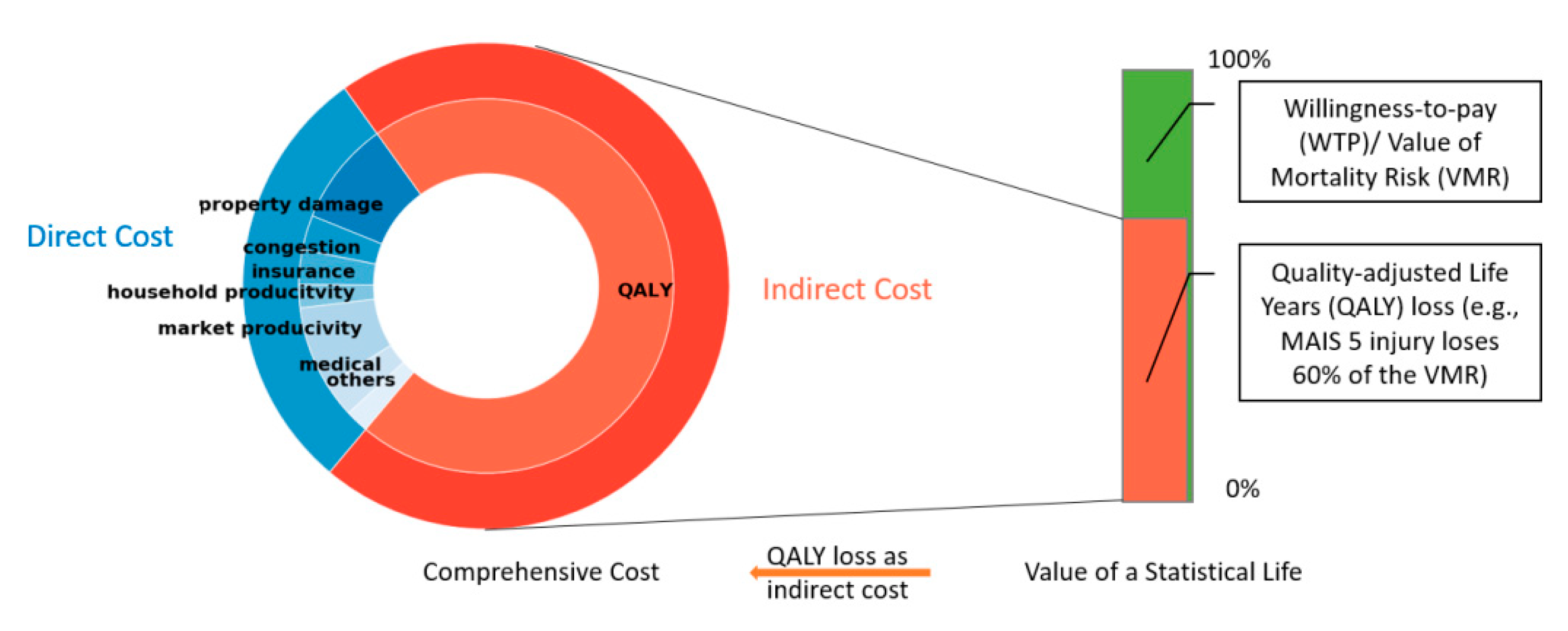
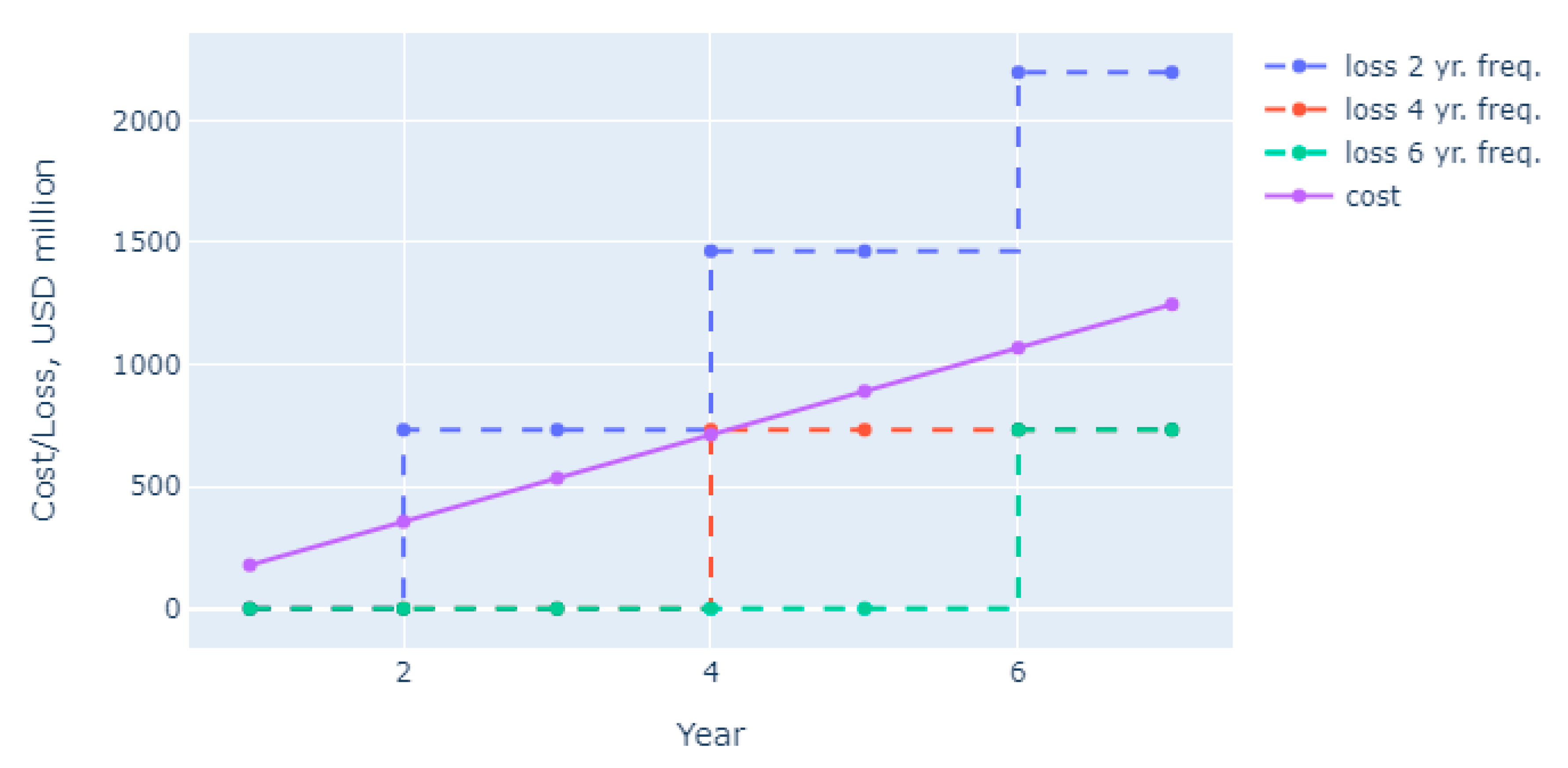
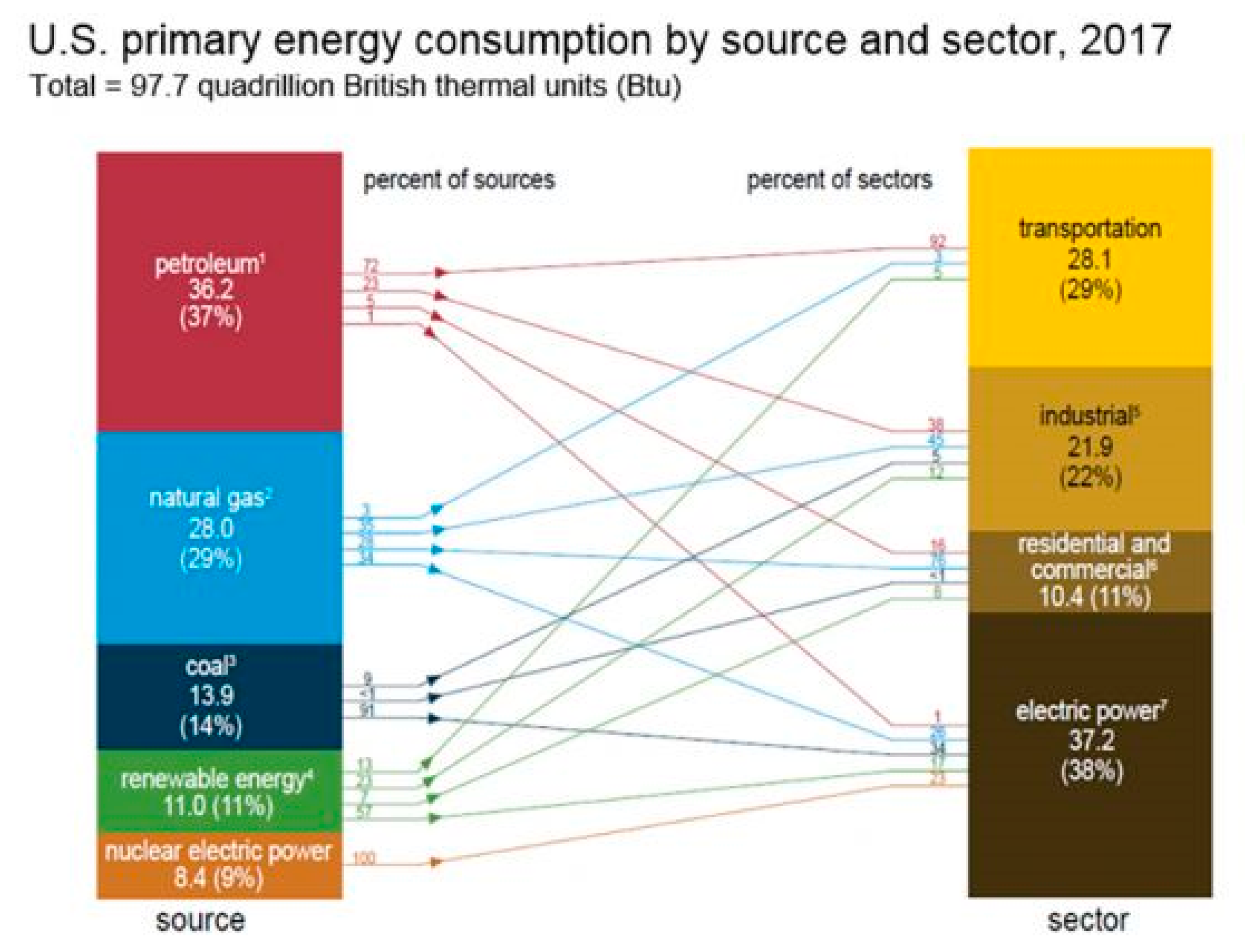
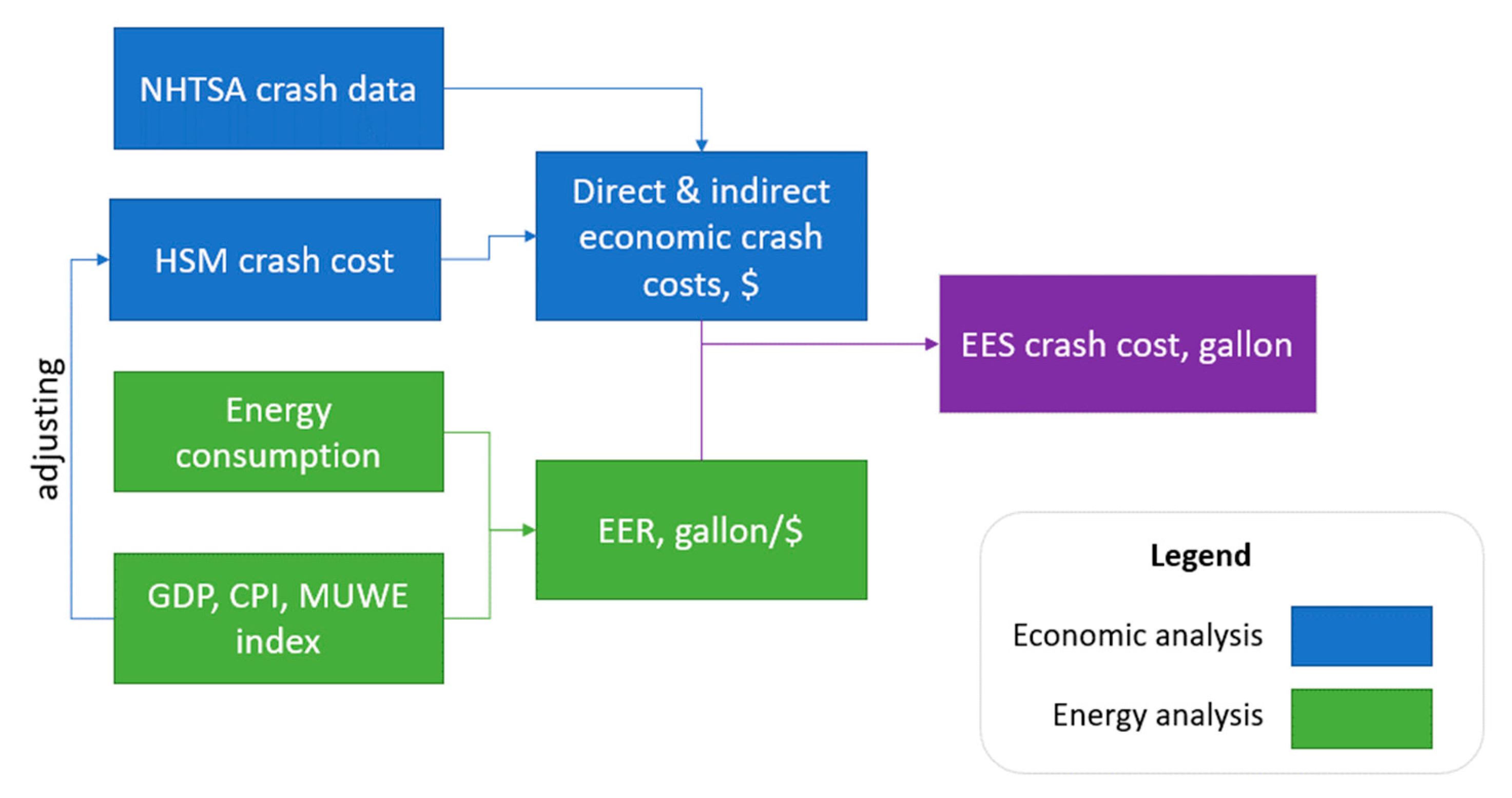

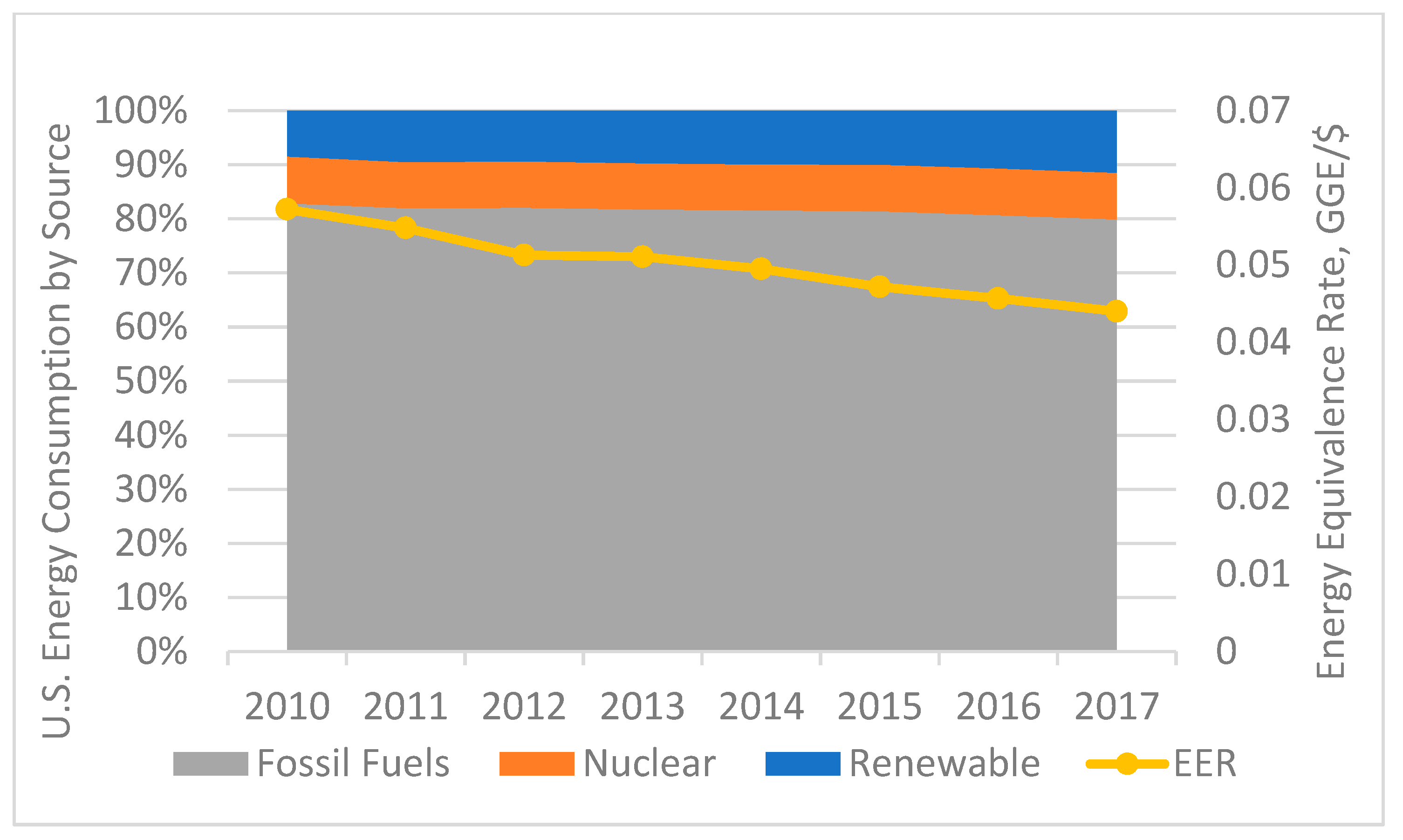
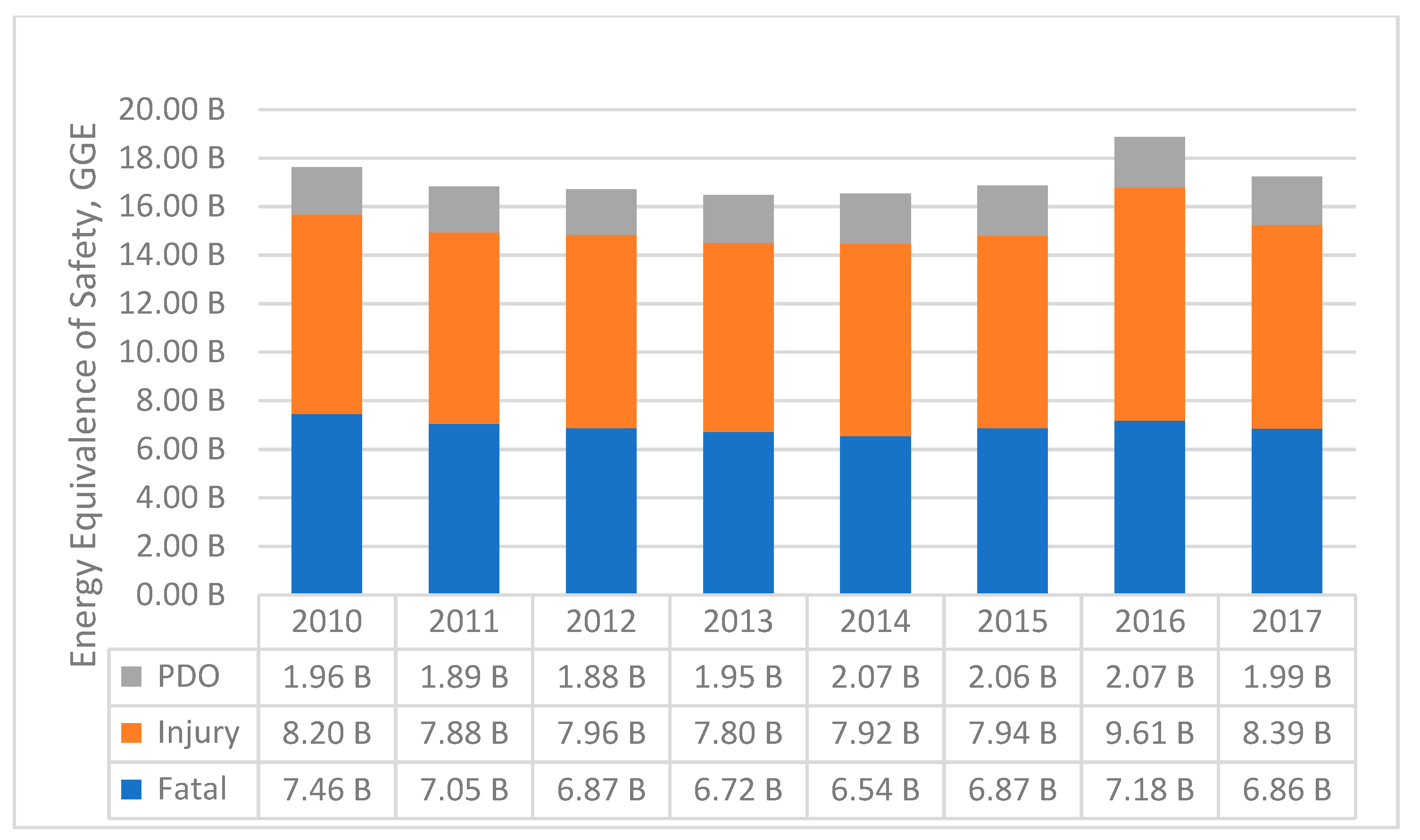
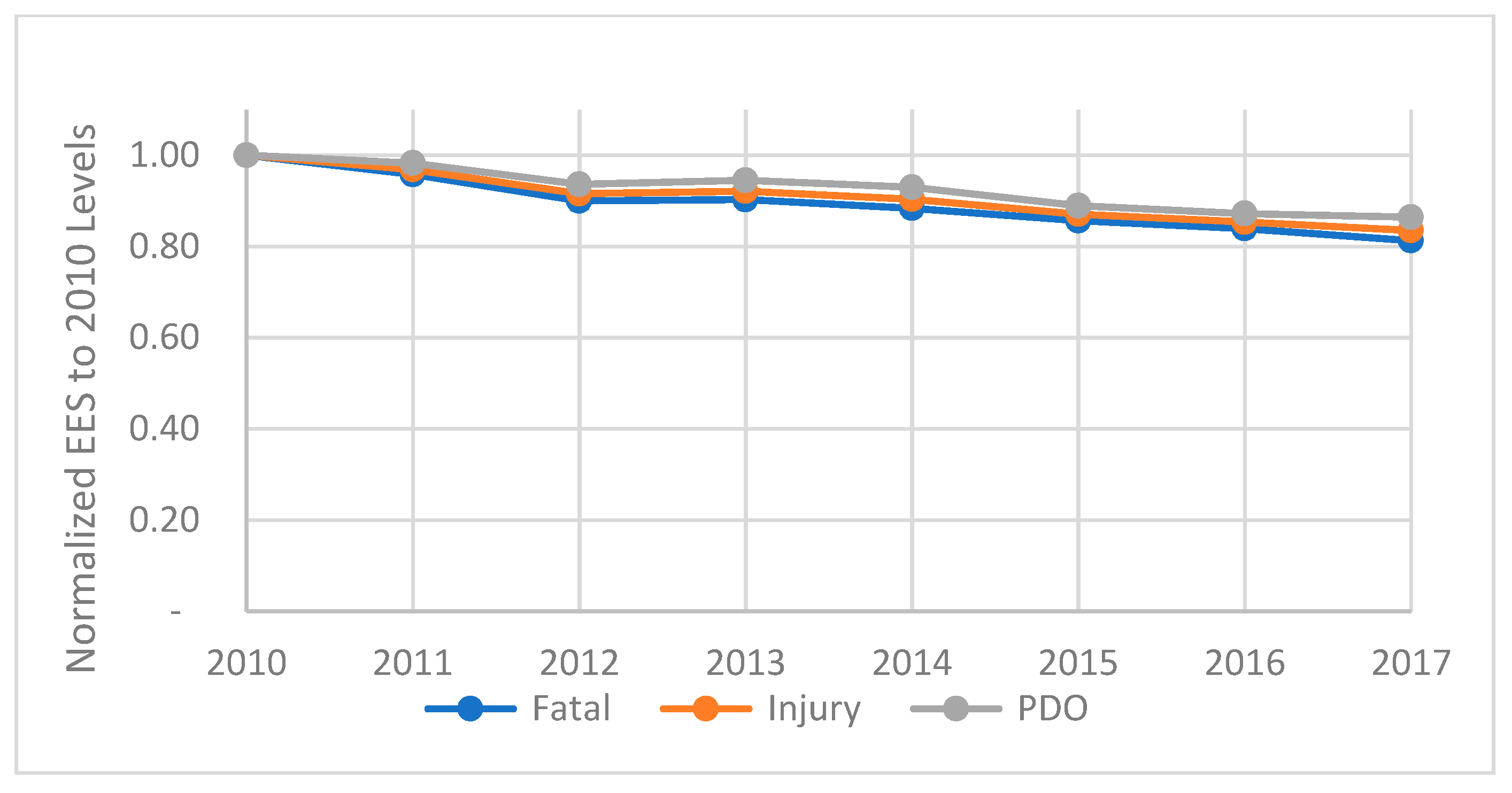
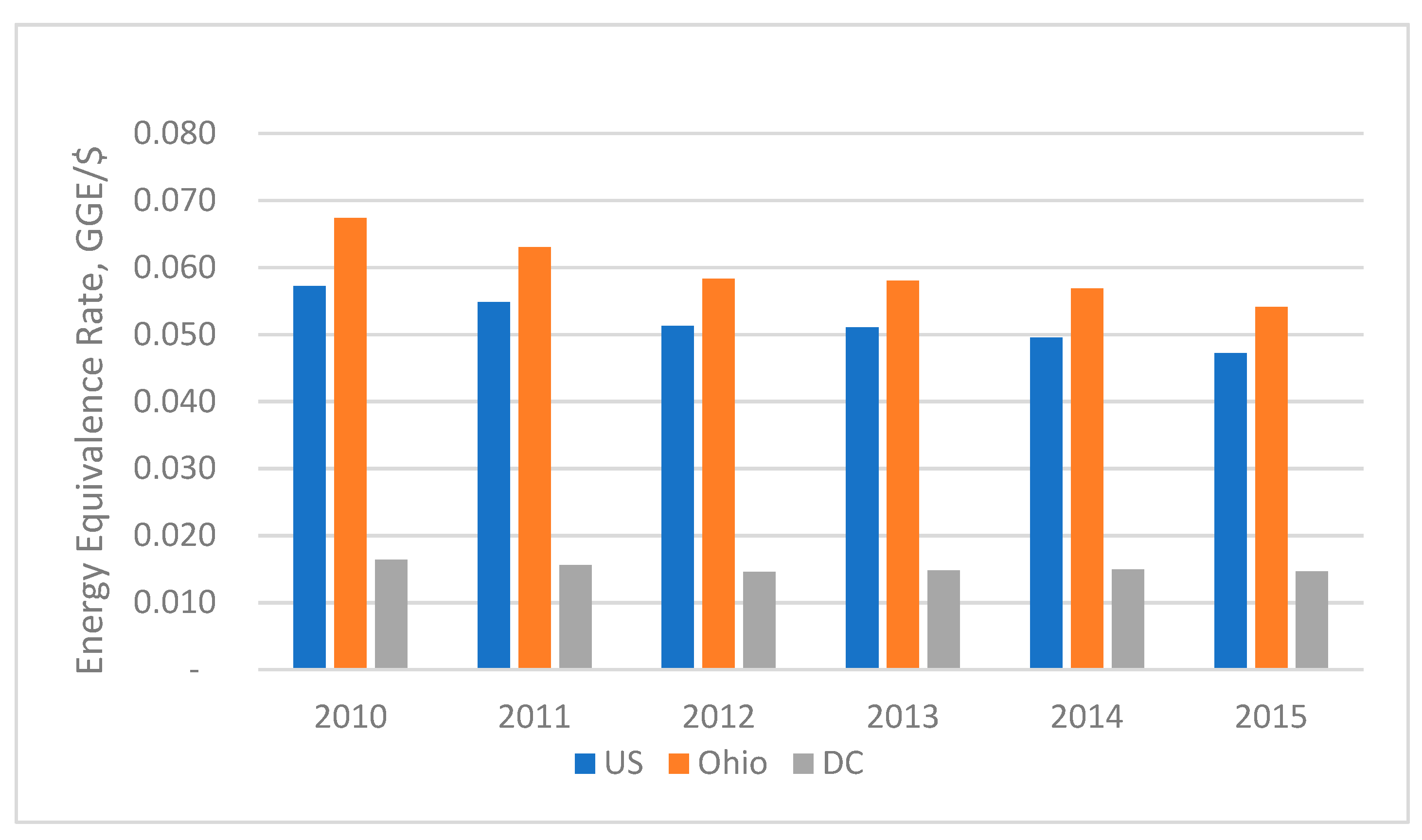

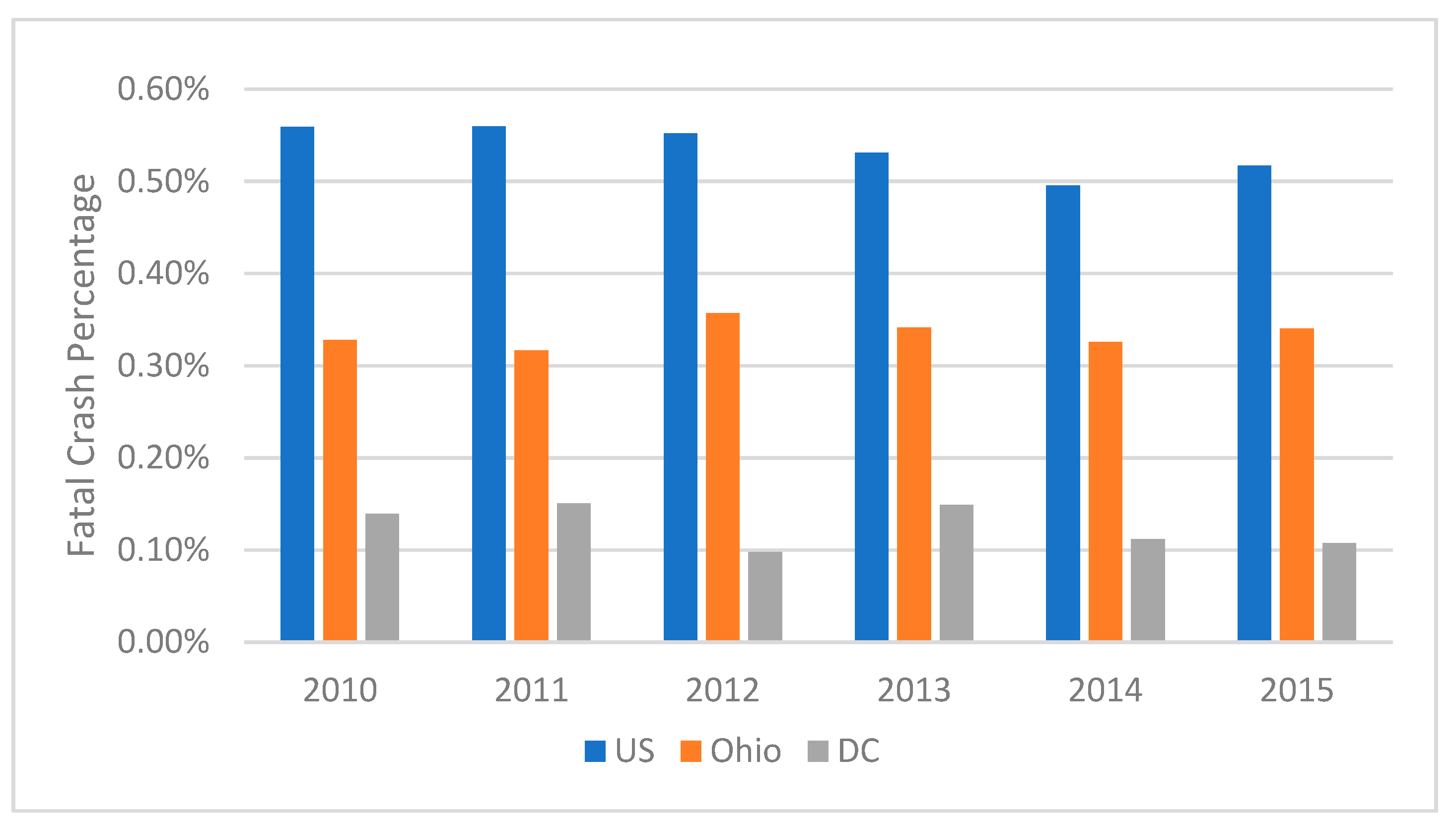
| Cost Category | Cost Item |
|---|---|
| Direct costs | Medical costs |
| Emergency medical services | |
| Lost productivity (short-term) | |
| Workplace losses | |
| Insurance administration costs | |
| Legal and court expenses | |
| Congestion costs | |
| Property damage costs | |
| Human capital cost (long-term) | |
| Indirect cost (monetized pain and suffering) | Quality-adjusted life year |
| Crash Severity (KABCO Scale) | Direct Unit Cost a (Economic Crash Unit Cost) | Indirect Unit Cost (QALY Crash Unit Cost) | Comprehensive Unit Cost | EPDO |
|---|---|---|---|---|
| Fatality (K) | $1,245,600 | $2,763,300 | $4,008,900 | 542 |
| Injury (A/B/C) | $44,268 | $38,332 | $82,600 | 11 |
| PDO (O) | $6400 | $1000 | $7400 | 1 |
| Year | Fatal | Injury | PDO | Total | |||
|---|---|---|---|---|---|---|---|
| 2010 | 30,296 | 0.56% | 1,542,000 | 28% | 3,847,000 | 71% | 5,419,296 |
| 2011 | 29,876 | 0.56% | 1,530,000 | 29% | 3,778,000 | 71% | 5,337,876 |
| 2012 | 31,006 | 0.55% | 1,634,000 | 29% | 3,950,000 | 70% | 5,615,006 |
| 2013 | 30,202 | 0.53% | 1,591,000 | 28% | 4,066,000 | 71% | 5,687,202 |
| 2014 | 30,056 | 0.50% | 1,648,000 | 27% | 4,387,000 | 72% | 6,065,056 |
| 2015 | 32,539 | 0.52% | 1,715,000 | 27% | 4,548,000 | 72% | 6,295,539 |
| 2016 | 34,748 | 0.51% | 2,116,000 | 31% | 4,670,000 | 68% | 6,820,748 |
| 2017 | 34,247 | 0.53% | 1,889,000 | 29% | 4,530,000 | 70% | 6,453,247 |
| Year | Fatal | Injury | PDO |
|---|---|---|---|
| 2010 | $4,305,731 | $92,973 | $8886 |
| 2011 | $4,305,139 | $94,009 | $9116 |
| 2012 | $4,321,692 | $94,949 | $9279 |
| 2013 | $4,353,499 | $95,903 | $9403 |
| 2014 | $4,396,230 | $97,070 | $9545 |
| 2015 | $4,471,366 | $98,155 | $9582 |
| 2016 | $4,525,052 | $99,359 | $9703 |
| 2017 | $4,548,077 | $100,882 | $9976 |
| Year | GDP (Trillion $) | Renewable Consumption Percentage | Nuclear Consumption Percentage | Fossil Fuels Consumption Percentage | Energy Consumption (Quads) | EER (Btu/$) |
|---|---|---|---|---|---|---|
| 2010 | 15.0 | 8.5% | 8.6% | 82.8% | 97.6 | 6523 |
| 2011 | 15.5 | 9.5% | 8.5% | 81.8% | 97.0 | 6248 |
| 2012 | 16.2 | 9.4% | 8.5% | 81.9% | 94.5 | 5848 |
| 2013 | 16.7 | 9.7% | 8.5% | 81.6% | 97.2 | 5824 |
| 2014 | 17.4 | 9.9% | 8.5% | 81.4% | 98.4 | 5645 |
| 2015 | 18.1 | 10.0% | 8.6% | 81.2% | 97.5 | 5380 |
| 2016 | 18.7 | 10.6% | 8.7% | 80.5% | 97.4 | 5209 |
| 2017 | 19.5 | 11.4% | 8.6% | 79.7% | 97.8 | 5020 |
| Category | Fatal (GGE) | Injury (GGE) | PDO (GGE) | ||||||
|---|---|---|---|---|---|---|---|---|---|
| Year | Direct | Indirect | Total | Direct | Indirect | Total | Direct | Indirect | Total |
| 2010 | 76,544 | 169,816 | 246,360 | 2873 | 2447 | 5320 | 439 | 69 | 508 |
| 2011 | 73,306 | 162,632 | 235,938 | 2782 | 2370 | 5152 | 433 | 68 | 501 |
| 2012 | 68,883 | 152,820 | 221,703 | 2630 | 2241 | 4871 | 412 | 64 | 476 |
| 2013 | 69,108 | 153,319 | 222,427 | 2646 | 2254 | 4900 | 415 | 65 | 480 |
| 2014 | 67,638 | 150,059 | 217,697 | 2596 | 2211 | 4807 | 409 | 64 | 473 |
| 2015 | 65,560 | 145,446 | 211,006 | 2501 | 2131 | 4632 | 391 | 61 | 452 |
| 2016 | 64,241 | 142,521 | 206,762 | 2452 | 2088 | 4540 | 383 | 60 | 443 |
| 2017 | 62,220 | 138,039 | 200,259 | 2399 | 2043 | 4442 | 380 | 59 | 439 |
| Year | Population [69] | Crash Number | EES per Crash (GGE) | ||||
|---|---|---|---|---|---|---|---|
| Fatal | Injury | PDO | Fatal | Injury | PDO | ||
| 2010 | 11,539,336 | 984 | 74,426 | 224,750 | 289,969 | 6261 | 598 |
| 2011 | 11,544,663 | 942 | 73,771 | 223,118 | 271,376 | 5926 | 575 |
| 2012 | 11,548,923 | 1024 | 72,105 | 213,956 | 252,037 | 5537 | 541 |
| 2013 | 11,576,684 | 918 | 69,104 | 199,056 | 252,558 | 5564 | 546 |
| 2014 | 11,602,700 | 919 | 69,917 | 211,532 | 249,987 | 5520 | 543 |
| 2015 | 11,617,527 | 1029 | 75,107 | 226,169 | 241,912 | 5310 | 518 |
| Year | Population | Crash Number | EES per Crash (GGE) | ||||
|---|---|---|---|---|---|---|---|
| Fatal | Injury | PDO | Fatal | Injury | PDO | ||
| 2010 | 605,226 | 25 | 5060 | 12,870 | 70,694 | 1526 | 146 |
| 2011 | 619,800 | 27 | 5210 | 12,714 | 66,981 | 1463 | 142 |
| 2012 | 634,924 | 18 | 5258 | 13,152 | 63,155 | 1388 | 136 |
| 2013 | 650,581 | 29 | 5358 | 14,069 | 64,462 | 1420 | 139 |
| 2014 | 662,328 | 24 | 5811 | 15,704 | 65,817 | 1453 | 143 |
| 2015 | 675,400 | 26 | 6215 | 18,024 | 65,582 | 1440 | 141 |
| Year | Energy Consumption (GGE) per Capita | GDP (USD) per Capita | ||||
|---|---|---|---|---|---|---|
| US | Ohio | DC | US | Ohio | DC | |
| 2010 | 2748 | 2912 | 2759 | 48,031 | 43,242 | 168,018 |
| 2011 | 2710 | 2886 | 2599 | 49,447 | 45,785 | 167,052 |
| 2012 | 2623 | 2779 | 2388 | 51,125 | 47,649 | 163,379 |
| 2013 | 2679 | 2830 | 2357 | 52,439 | 48,778 | 159,150 |
| 2014 | 2692 | 2899 | 2374 | 54,353 | 50,978 | 158,595 |
| 2015 | 2648 | 2828 | 2318 | 56,111 | 52,277 | 158,043 |
© 2020 by the authors. Licensee MDPI, Basel, Switzerland. This article is an open access article distributed under the terms and conditions of the Creative Commons Attribution (CC BY) license (http://creativecommons.org/licenses/by/4.0/).
Share and Cite
Zhong, Z.; Zhu, L.; Young, S. Approximation Framework of Embodied Energy of Safety: Insights and Analysis. Energies 2020, 13, 4230. https://doi.org/10.3390/en13164230
Zhong Z, Zhu L, Young S. Approximation Framework of Embodied Energy of Safety: Insights and Analysis. Energies. 2020; 13(16):4230. https://doi.org/10.3390/en13164230
Chicago/Turabian StyleZhong, Zijia, Lei Zhu, and Stanley Young. 2020. "Approximation Framework of Embodied Energy of Safety: Insights and Analysis" Energies 13, no. 16: 4230. https://doi.org/10.3390/en13164230
APA StyleZhong, Z., Zhu, L., & Young, S. (2020). Approximation Framework of Embodied Energy of Safety: Insights and Analysis. Energies, 13(16), 4230. https://doi.org/10.3390/en13164230





